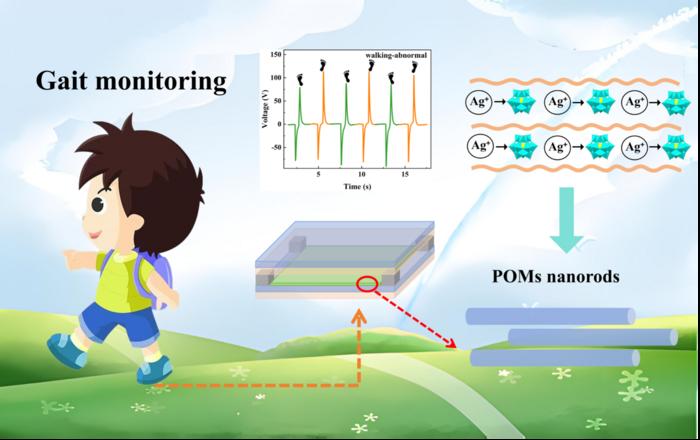
A groundbreaking advancement has emerged in the realm of energy harvesting and wearable technology. Researchers from Northeast Normal University in Changchun, Jilin Province, China, led by Professor Weilin Chen, have developed a cutting-edge triboelectric nanogenerator (TENG) utilizing polyoxometalates (POMs) to significantly enhance gait monitoring for teenagers. This innovative device addresses an important challenge in health monitoring by providing a lightweight, flexible, and portable solution that can effectively capture the nuances of a teenager’s gait.
The team’s novel approach involved changing the nanomorphology of POMs, leading to the synthesis of nanorods that serve as triboelectric materials. These nanorods, composed of Ag4SiW12O40·nH2O, were carefully engineered to achieve optimal performance. The fine-tuning of these materials has resulted in the TENG producing a voltage output surpassing 100 volts, a current density exceeding 1100 μA·m−2, and a charge capacity of near 15.38 nC. Such impressive metrics indicate a performance enhancement more than double compared to previous iterations composed solely of POMs.
The TENG designed by this team not only excels in performance but also opens new avenues in wearable technology. It allows for real-time monitoring of gait abnormalities, which is crucial during the critical years of skeletal development in teenagers. The implications are substantial; as experts highlight, improper gait can lead to physical issues such as poor posture and increased susceptibility to injuries. Therefore, this advanced monitoring tool could significantly contribute to improving the physical health and wellbeing of the youth.
In their meticulous study, the researchers conducted various performance tests that highlighted the unique attributes of the POMs nanorods. Enhanced performance was attributed to increased surface roughness and elevated surface potential, confirmed through atomic force microscopy (AFM) and Kelvin probe force microscopy (KPFM). These findings not only validate their design approach but also demonstrate the effectiveness of utilizing advanced materials within energy-generating platforms.
As part of their research, the team conducted extensive trials with the TENGs affixed to the left and right feet of different teenage subjects. The varying voltage outputs were able to sensitively reveal inconsistencies and abnormalities in gait patterns. This reflectivity offers a real-time health surveillance component that could play a pivotal role in preventing long-term physical problems related to improper gait.
Professor Chen emphasized the broader vision behind this research, illustrating a strong desire to expand the application fields of polyoxometalates and to fully tap into their potential within the realm of nanogenerators. This zeal for innovation is supported by the team’s track record, which showcases their commitment to publishing notable findings in the field of TENGs and their applications over recent years.
The significance of this work is further underscored by the financial backing received from various scientific foundations, including the National Natural Science Foundation of China and the Education Department of Jilin Province. Such funding demonstrates the scholarly community’s recognition of the potential impact this research can have, particularly in the fields of energy conversion and health monitoring.
Looking ahead, the research team is poised to continue exploring the capabilities of POMs nanorods in TENG applications. Their goal is to bring this technology beyond the laboratory setting, effectively transitioning it into practical applications that could benefit health monitoring systems in real-world settings. This ambition underscores a critical commitment to innovation and collaboration, as they aim to develop even more efficient POMs nanomaterials for future energy harvesting devices.
Through the study of POMs, the researchers have tapped into a wellspring of potential within the field of nanotechnology. Their dedication to enhancing energy conversion devices positions them at the forefront of scientific research that merges material science with real-world health applications. As they disseminate their findings to the scientific community, their work is bound to inspire further research and development within the energy harvesting domain.
In conclusion, the advent of triboelectric nanogenerators using engineered polyoxometalates highlights a significant crossover between material science and health technology. The meticulous work of Chen and his team paves a promising path for future developments in wearable health devices, intensifying interest in renewed pursuits within nanotechnology and energy systems. The journey of this research reflects a vital intersection of health innovation and renewable energy solutions that can resonate with many sectors of society.
—
Subject of Research: Triboelectric nanogenerator based on changing the nanomorphology of polyoxometalates for gait monitoring of teenagers
Article Title: Triboelectric nanogenerator based on changing the nanomorphology of polyoxometalates for gait monitoring of teenagers
News Publication Date: 13-Jan-2025
Web References: https://doi.org/10.26599/NR.2025.94907192
References: None provided
Image Credits: Nana Research, Tsinghua University Press.
Keywords
Triboelectric nanogenerator, Polyoxometalates, Gait Monitoring, Wearable Technology, Energy Harvesting, Health Monitoring, Nanorods, Performance Enhancement, Teenagers, Material Science.
Tags: advancements in wearable technologyAg4SiW12O40 nanorodsenergy harvesting innovationsflexible and portable health solutionsnanomorphology of nanorodsperformance enhancement of TENGspolyoxometalates in energy harvestingreal-time gait analysisteen gait monitoring technologyteenage skeletal developmenttriboelectric nanogeneratorswearable health monitoring devices





